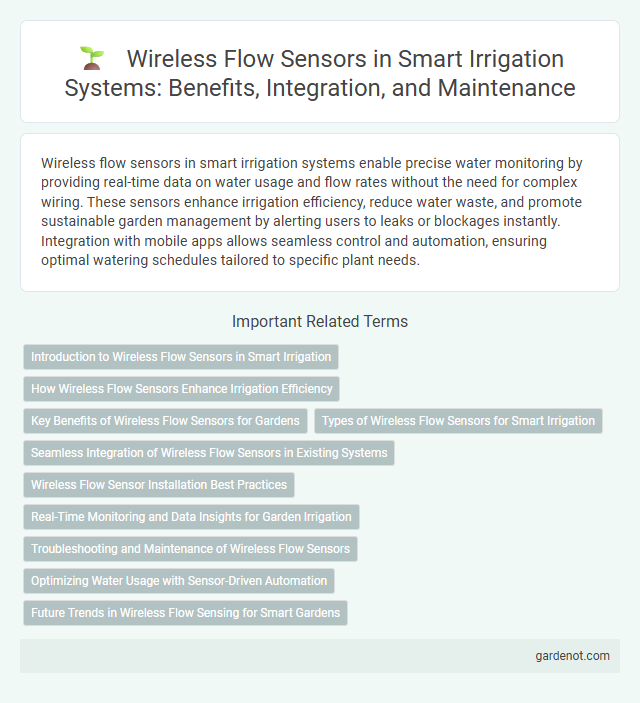Wireless flow sensors in smart irrigation systems enable precise water monitoring by providing real-time data on water usage and flow rates without the need for complex wiring. These sensors enhance irrigation efficiency, reduce water waste, and promote sustainable garden management by alerting users to leaks or blockages instantly. Integration with mobile apps allows seamless control and automation, ensuring optimal watering schedules tailored to specific plant needs.
Introduction to Wireless Flow Sensors in Smart Irrigation
Wireless flow sensors in smart irrigation systems provide precise real-time monitoring of water flow, enabling efficient water management and leak detection. These sensors transmit data wirelessly to centralized controllers or cloud platforms, facilitating remote access and automation for optimized irrigation schedules. By reducing water waste and ensuring uniform distribution, wireless flow sensors significantly enhance crop health and conserve resources in agricultural practices.
How Wireless Flow Sensors Enhance Irrigation Efficiency
Wireless flow sensors provide real-time data on water usage and flow rates, enabling precise control of irrigation systems to minimize waste. These sensors detect leaks, blockages, or abnormal flow patterns early, preventing overwatering and reducing water consumption. Integration with smart irrigation controllers ensures optimal scheduling based on soil moisture, weather conditions, and crop needs, significantly enhancing water efficiency and crop health.
Key Benefits of Wireless Flow Sensors for Gardens
Wireless flow sensors for gardens provide precise, real-time monitoring of water usage, enabling efficient irrigation management that conserves water and reduces waste. Their wireless connectivity facilitates easy installation and remote data access, allowing gardeners to optimize watering schedules based on accurate flow measurement. These sensors help prevent overwatering and detect leaks early, contributing to healthier plants and sustainable garden maintenance.
Types of Wireless Flow Sensors for Smart Irrigation
Wireless flow sensors for smart irrigation include ultrasonic, electromagnetic, and turbine types, each offering precise water usage data without physical connections. Ultrasonic sensors use sound waves to measure flow velocity, ideal for non-invasive installation and low maintenance in irrigation systems. Electromagnetic sensors detect flow by measuring voltage induced by water movement, providing high accuracy with no moving parts, while turbine sensors rely on a rotating blade to gauge flow rate, favored for cost-effectiveness and simplicity in agricultural applications.
Seamless Integration of Wireless Flow Sensors in Existing Systems
Wireless flow sensors enable seamless integration into existing smart irrigation systems by utilizing advanced communication protocols like LoRaWAN and Zigbee, ensuring real-time data transmission without extensive infrastructure changes. These sensors provide accurate flow measurements that optimize water usage and detect leaks early, directly enhancing irrigation efficiency. Compatibility with major irrigation controllers and cloud management platforms facilitates effortless upgrades and centralized monitoring, reducing installation time and operational costs.
Wireless Flow Sensor Installation Best Practices
Wireless flow sensor installation best practices include selecting optimal locations free from obstructions to ensure accurate water flow measurements and reliable signal transmission. Proper mounting using manufacturer-recommended brackets and seals protects sensors from environmental damage and maintains data integrity. Regular calibration and battery monitoring are essential to sustain efficient operation and prevent irrigation system failures.
Real-Time Monitoring and Data Insights for Garden Irrigation
Wireless flow sensors enable real-time monitoring of water usage in garden irrigation systems, providing precise data on flow rates and leaks. These sensors transmit continuous data to smart controllers, optimizing irrigation schedules based on actual water consumption and soil moisture levels. Enhanced data insights from wireless flow sensors help conserve water, reduce costs, and improve overall garden health by ensuring efficient water distribution.
Troubleshooting and Maintenance of Wireless Flow Sensors
Troubleshooting wireless flow sensors often involves checking for signal interference, battery status, and sensor calibration to ensure accurate water flow measurements. Regular maintenance includes cleaning sensor components to prevent debris buildup, inspecting wiring connections, and updating firmware to optimize performance and extend device lifespan. Implementing a routine monitoring schedule helps detect anomalies early, minimizing irrigation system downtime and water waste.
Optimizing Water Usage with Sensor-Driven Automation
Wireless flow sensors enable precise monitoring of water usage in smart irrigation systems, reducing waste by providing real-time data for automated adjustments. These sensors detect variations in flow rates, allowing the system to optimize irrigation schedules based on soil moisture and weather conditions. Sensor-driven automation enhances water conservation efforts while maintaining optimal plant health and improving overall agricultural efficiency.
Future Trends in Wireless Flow Sensing for Smart Gardens
Wireless flow sensors in smart gardens are advancing towards enhanced energy efficiency and real-time data integration with AI-driven irrigation systems. Emerging trends include ultra-low power consumption sensors powered by energy harvesting technologies and improved wireless communication protocols, such as LPWAN and 5G, enabling larger-scale deployment and precise water usage monitoring. The future also emphasizes seamless integration with IoT platforms for adaptive irrigation scheduling, promoting sustainable water management and improved plant health.
Wireless flow sensor Infographic

 gardenot.com
gardenot.com